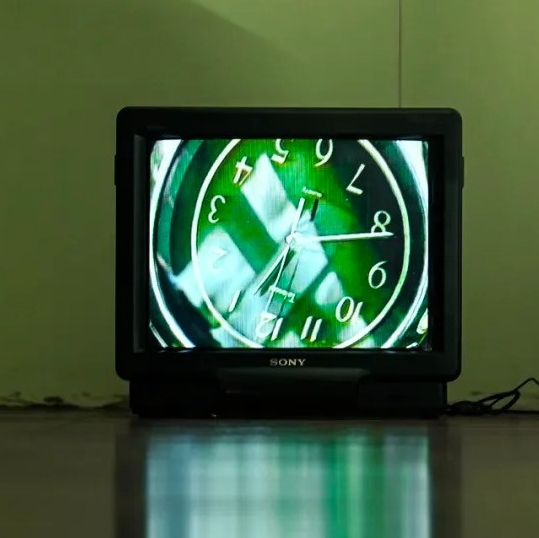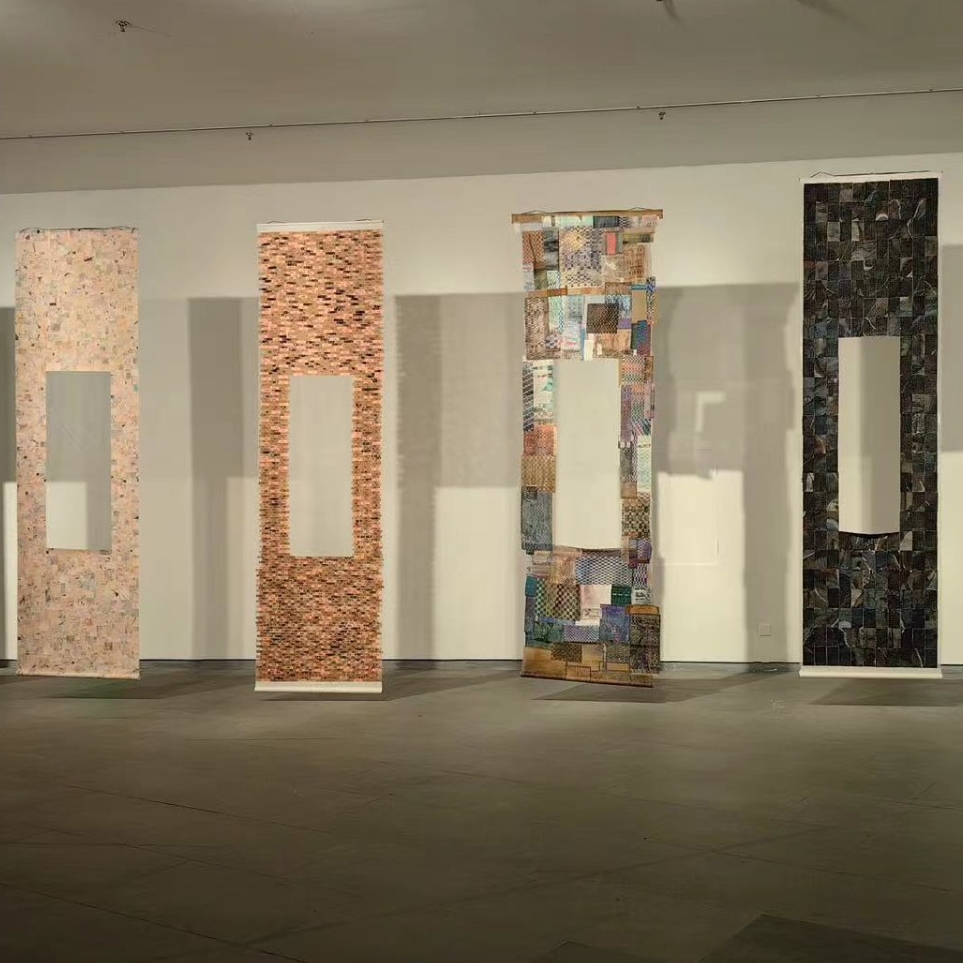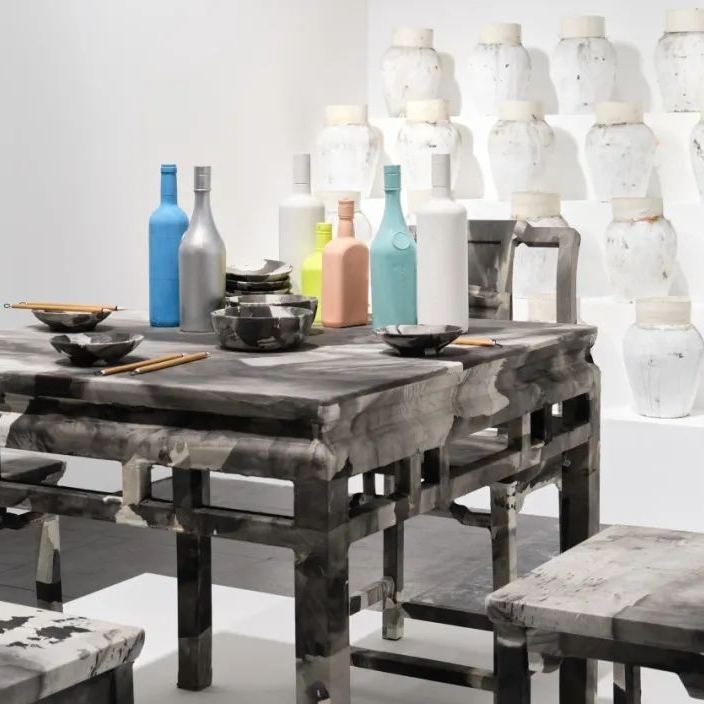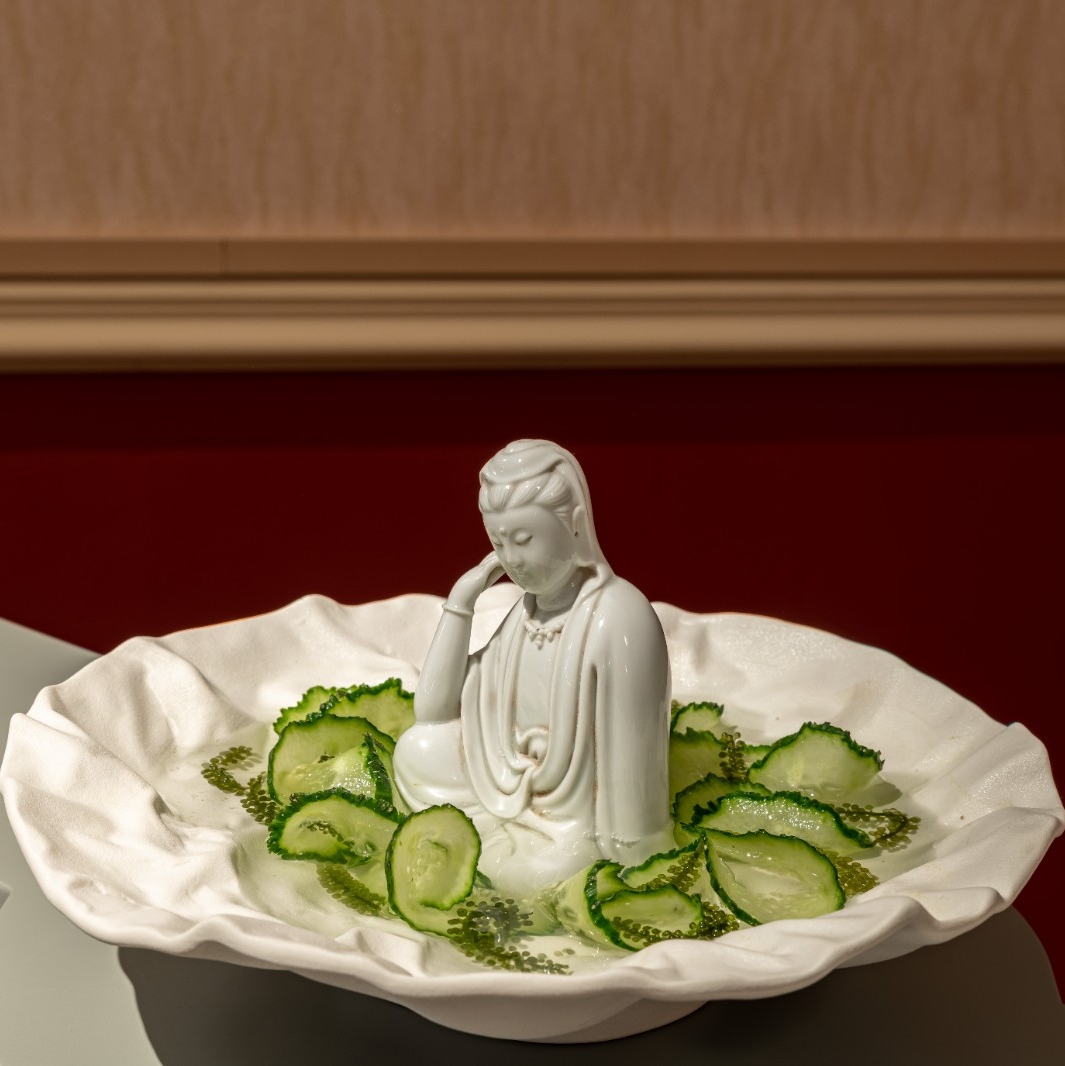
Exhibition View
“If you love nature, you have to love the dirty side of nature.”
—Hai Zi
Before the opening of the exhibition, poet Xi Chuan sent Wu Xiaohai a poem by Hai Zi: “If you love nature, you have to love the dirty side of nature.” Dirtiness, as opposed to truth, goodness and beauty, is a demarcation of standards and a product of culture. However, it is the so-called dirtiness and mess that provide a breeding ground for diversity and leave room for individuality and even prejudice. The development of art comes exactly from individuality.
Prior to the opening of the exhibition, the artist copied this poem onto a wooden panel in the exhibition hall, and even wrote the word “dirtiness” wrong – as in the other corners of the third-floor gallery, showing chaos and casualness. Wu Xiaohai’s solo exhibition “Intranquil Nature” starts from observing and following a dynamic route towards chaos and nature.

Wu Xiaohai, The sun shone, 450x430cm, Acrylic on canvas, 2022
Watching and Interpreting
Wu Xiaohai has stayed in the Xiangshui Lake in Huairou for four months, with a large canvas stand of over four meters in length and width being set up in a forest clearing, and he painted from morning to night in daylight, including bare trees to luxuriant trees, thus producing an astonishing volume and number of works for the “Intranquil Nature” exhibition. These giant oil paintings are different from traditional sketches – the overall picture is well-distributed, and you can’t find the focus point of the painting, nor can you feel the sense of space and distance.
Wu Xiaohai’s sketches do not attempt to address the problem of sketching, but rather observing – “I remind myself to return to the natural function of the naked eye, to move and focalize, rather than the sketching method that is guided by ‘culture’”. The homogenized pictures are the result of the artist’s “natural observing” and faithful portrayal of nature.

Wu Xiaohai's Diaries between 2019 and 2022
Up to the second floor, there are nearly 100 small sketches displayed along the wall in the dimly lit space with depictions such as a freak in the mountain, fishing for the moon in the water, and a huge monster…one by one, they seem to recount anecdotes that happened in the deep mountains and forests. This is a trick of the artist, as well as a mockery of the viewer’s act of observing: with any art that contains figurative forms or recognizable images, people always instinctively apply their experience to observing. In fact, “there is no story in these sketches. Even if I change a few pictures, the viewer will still make associations spontaneously.” The artist does not have to set meaning for himself, and the viewers will find it for themselves. The dimly lit second floor is a “trap” that Wu Xiaohai has designed for the viewer.


Wu Xiaohai, Figure II, 10x 100x76cm, Bronze, 2022
The same “challenge” can be found on the third floor, where drawings on the wooden panels reveal the shadow by the romantic artist Caspar David Fredrich and the signature of Eugene Delacroix in 1854, and the sculptures in the form of natural creatures have been given human-oriented names such as Lao Wang and Prince. The artist has deliberately arranged these “information interfaces” so that the viewer can extract familiar and safe elements and transform them to complete what Sontag calls the “interpretation”, thus making the art “controllable and submissive.”
Therefore, it’s also a challenge for me to write for Wu Xiaohai’s exhibition. Whether starting from the images of the works or the expression of the artist, the information and experiences obtained constantly intertwine with each other, while the artist is precisely alert to the intervention of such a cultural context and attempts to keep experience out of observing, returning to the naive state of nature.
Human and Technology
Curator Zhang Zikang describes Wu Xiaohai’s way of observing as “scanning” and his presentation as “replication.” These mechanical terms bring up another focus of the works in this exhibition, inconspicuous but present in the artist’s creative process – technology.
In addition to reflecting on the humanities, the impact of technological revolutions runs through Wu Xiaohai’s creations. Since 2015, Wu Xiaohai has incorporated artificial intelligence (AI) in his works. Working with the research and development team of an artificial intelligence company in Shanghai for three years, he has produced works with distinct technical elements such as Way Out and The Thousand-Hand Guanyin. In Way Out, a sensitive underwater operating robot arm wields a scalpel and tries to kill the fish in a two-meter-square tank, but it never injures them and brings oxygen into the water tank, leaving the seemingly “stupid” fish unharmed by the sharpest mechanical arm. The artist makes great use of technology in his creations and expresses a distinct tone of sarcasm that artificial intelligence has not yet replaced the human body.

Exhibition View

Wu Xiaohai, Night, 35x28x26cm, Ceramic, 2013
The opening of the “Intranquil Nature” exhibition coincides with the popularity of ChatGPT, which inspired the three-floor space arrangement. According to the artist, ChatGPT integrates everyone’s ideas in a seemingly truthful and comprehensive way, but in fact, it is just a bunch of hollow words. The so-called “machine learning” is nothing but the collation and summarizing of information, while the non-repetition of human learning often comes from a flash of inspiration in the chaos.
Therefore, on the wooden panels that divide the space on three floors, the disorderly black and white printed images reflect the actions of human beings towards nature, with spray paint and carbon strips painted freely on the picture…these brushstrokes are an improvisational move by the artist to create a state of chaos in a structured space in the opening ceremony of the exhibition. In the chaos, a statue with what appears to be holy light behind it, whose face resembles that of the artist, rests on a precariously slender pedestal. If you look carefully, the holy light actually refers to an ancient Chinese custom – “stick up a wisp of straw and make known that one is for sale”. The artist’s canonization of himself is accompanied by his own label of sale, expressing his doubts about the crisis of human faith: why do people need to make gods? Does the crisis of faith come from the usual historical reasons or does man really need the leadership of a ruler? From the god of religion in the past to the god of technology, Wu Xiaohai believes that the ultimate core remains the issue of “humans.”

Exhibition View
Life
As you understand the artist’s disregard and even contempt for the established rules, the overwhelming richness of the media in the exhibition seems very logical. Both the references to historical art images and the use of media serves as an information interface that Wu Xiaohai has chosen for the viewer. He selects what is useful from convention but refuses to rely on them.
As Heidegger is quoted on the wall of the gallery, “Nature itself is a being, which appears within the world and can be discovered through different paths and steps.” On either side of the famous saying, the artist has pressed his handprints – a satire on cultural regulations as well as a disruption of formalities. For an entire culture represented by Heidegger, Wu Xiaohai remains skeptical and vigilant.


Exhibition View
Having spent most of his life on art, Wu Xiaohai naturally connects art with life, and his fascination with nature comes from this instinct. The mud-like texture recurs in Wu Xiaohai’s sculptural works, which is a borrowing of the natural texture – the waves wash the shellfish ashore, and the reef grows as the creatures attached to it accumulate constantly – inanimate rocks grow as well.
The relationship between man, technology and nature forms the core of Wu Xiaohai’s creation, with the three correlating with each other. The artist hopes to rethink the value of disorderly and irrational objects, and the entire exhibition space and the works therein serve as a visual reflection of his philosophy.


Exhibition View Wu Xiaohai, Portrait, 5930x2160cm, Video, 2022
Wu Xiaohai, Portrait, 5930x2160cm, Video, 2022
In the final space of the exhibition – an easily overlooked mezzanine, a pregnant mermaid lies on her side at the end of the floor, with her bulging belly hanging slightly to the ground, as if in labor. The fertile fish symbolizes myriads of lives in their infancy. Behind her is a full sheet of misty glass, the shadows of the trees dancing and changing every moment with the sunlight. On the opposite wall, a black and white mosaic of a forest clearing is positioned in contrast, revealing the “dullness of human cultural production.” This shadow of trees is the end of the “Intranquil Nature” exhibition and also the destination of the artist’s pursuit – the closest thing to real nature, and the rest are just foils.
Courtesy of the Artist and edited by CAFA ART INFO.
About the Exhibition

“Wu Xiaohai: Intranquil Nature”
Duration: March 3–April 16, 2023
Venue: IOMA Space
Courtesy of Wu Xiaohai and IOMA Space.




























